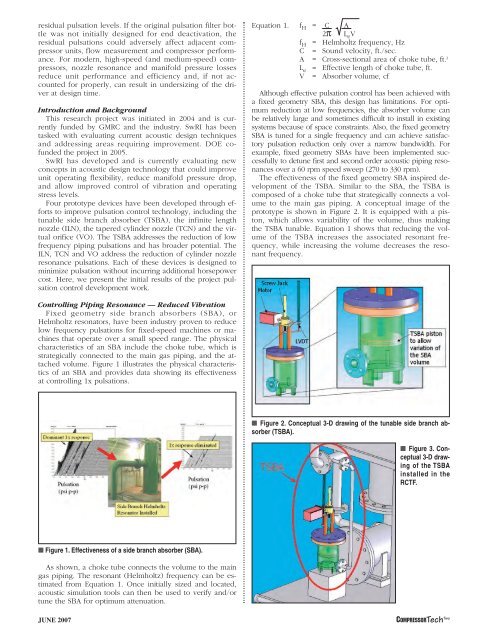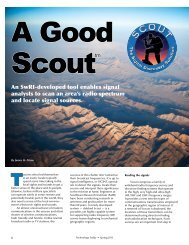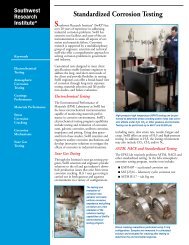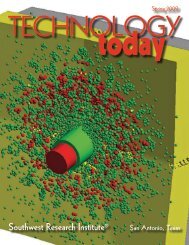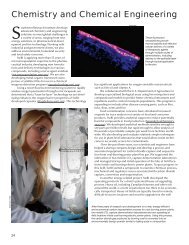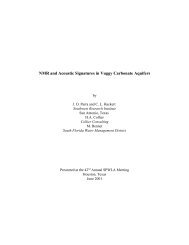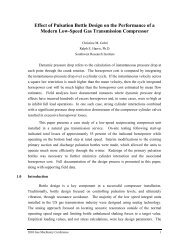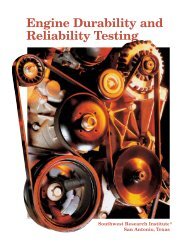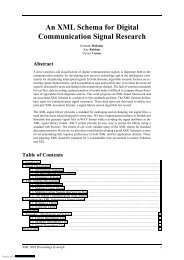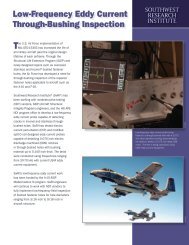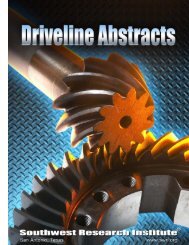gmrc advanced reciprocating compressor technology - Southwest ...
gmrc advanced reciprocating compressor technology - Southwest ...
gmrc advanced reciprocating compressor technology - Southwest ...
Create successful ePaper yourself
Turn your PDF publications into a flip-book with our unique Google optimized e-Paper software.
esidual pulsation levels. If the original pulsation filter bottle<br />
was not initially designed for end deactivation, the<br />
residual pulsations could adversely affect adjacent <strong>compressor</strong><br />
units, flow measurement and <strong>compressor</strong> performance.<br />
For modern, high-speed (and medium-speed) <strong>compressor</strong>s,<br />
nozzle resonance and manifold pressure losses<br />
reduce unit performance and efficiency and, if not accounted<br />
for properly, can result in undersizing of the driver<br />
at design time.<br />
Introduction and Background<br />
This research project was initiated in 2004 and is currently<br />
funded by GMRC and the industry. SwRI has been<br />
tasked with evaluating current acoustic design techniques<br />
and addressing areas requiring improvement. DOE cofunded<br />
the project in 2005.<br />
SwRI has developed and is currently evaluating new<br />
concepts in acoustic design <strong>technology</strong> that could improve<br />
unit operating flexibility, reduce manifold pressure drop,<br />
and allow improved control of vibration and operating<br />
stress levels.<br />
Four prototype devices have been developed through efforts<br />
to improve pulsation control <strong>technology</strong>, including the<br />
tunable side branch absorber (TSBA), the infinite length<br />
nozzle (ILN), the tapered cylinder nozzle (TCN) and the virtual<br />
orifice (VO). The TSBA addresses the reduction of low<br />
frequency piping pulsations and has broader potential. The<br />
ILN, TCN and VO address the reduction of cylinder nozzle<br />
resonance pulsations. Each of these devices is designed to<br />
minimize pulsation without incurring additional horsepower<br />
cost. Here, we present the initial results of the project pulsation<br />
control development work.<br />
Equation 1. f H = C A<br />
2π L e V<br />
f H = Helmholtz frequency, Hz<br />
C = Sound velocity, ft./sec.<br />
A = Cross-sectional area of choke tube, ft. 2<br />
L e = Effective length of choke tube, ft.<br />
V = Absorber volume, cf<br />
Although effective pulsation control has been achieved with<br />
a fixed geometry SBA, this design has limitations. For optimum<br />
reduction at low frequencies, the absorber volume can<br />
be relatively large and sometimes difficult to install in existing<br />
systems because of space constraints. Also, the fixed geometry<br />
SBA is tuned for a single frequency and can achieve satisfactory<br />
pulsation reduction only over a narrow bandwidth. For<br />
example, fixed geometry SBAs have been implemented successfully<br />
to detune first and second order acoustic piping resonances<br />
over a 60 rpm speed sweep (270 to 330 rpm).<br />
The effectiveness of the fixed geometry SBA inspired development<br />
of the TSBA. Similar to the SBA, the TSBA is<br />
composed of a choke tube that strategically connects a volume<br />
to the main gas piping. A conceptual image of the<br />
prototype is shown in Figure 2. It is equipped with a piston,<br />
which allows variability of the volume, thus making<br />
the TSBA tunable. Equation 1 shows that reducing the volume<br />
of the TSBA increases the associated resonant frequency,<br />
while increasing the volume decreases the resonant<br />
frequency.<br />
Controlling Piping Resonance — Reduced Vibration<br />
Fixed geometry side branch absorbers (SBA), or<br />
Helmholtz resonators, have been industry proven to reduce<br />
low frequency pulsations for fixed-speed machines or machines<br />
that operate over a small speed range. The physical<br />
characteristics of an SBA include the choke tube, which is<br />
strategically connected to the main gas piping, and the attached<br />
volume. Figure 1 illustrates the physical characteristics<br />
of an SBA and provides data showing its effectiveness<br />
at controlling 1x pulsations.<br />
■ Figure 2. Conceptual 3-D drawing of the tunable side branch absorber<br />
(TSBA).<br />
■ Figure 3. Conceptual<br />
3-D drawing<br />
of the TSBA<br />
installed in the<br />
RCTF.<br />
■ Figure 1. Effectiveness of a side branch absorber (SBA).<br />
As shown, a choke tube connects the volume to the main<br />
gas piping. The resonant (Helmholtz) frequency can be estimated<br />
from Equation 1. Once initially sized and located,<br />
acoustic simulation tools can then be used to verify and/or<br />
tune the SBA for optimum attenuation.<br />
JUNE 2007<br />
COMPRESSORTech Two


